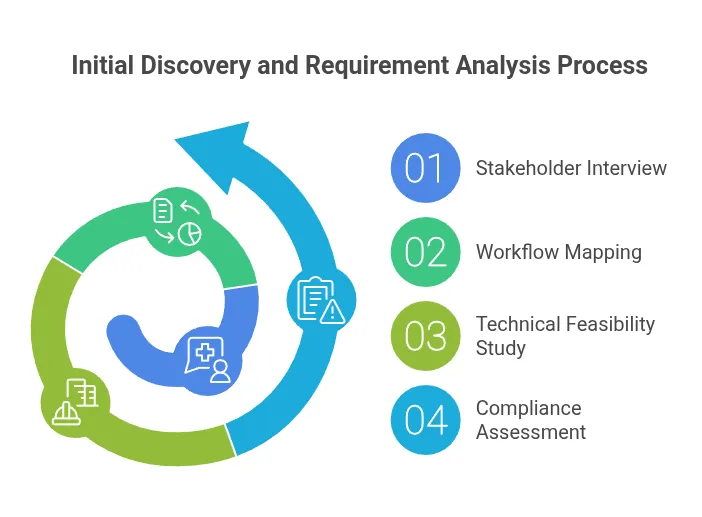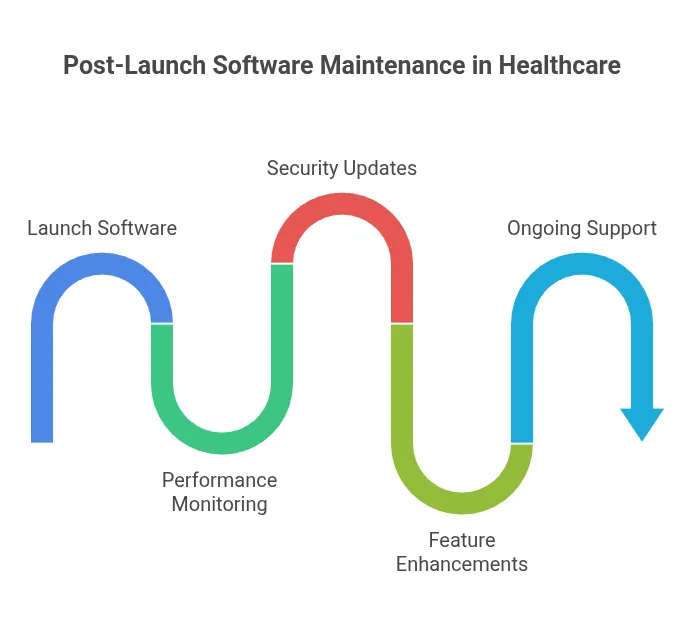Table of Contents
The healthcare industry is rapidly changing with new technology to improve patient care, streamline operations, and enhance medical data security efficiently. While off-the-shelf solutions exist, they often fail to meet the unique requirements of hospitals, clinics, and custom telehealth software providers.
That’s where custom healthcare software development comes in.
With this, you can take care of everything, starting from initial discovery to post-launch support. This process requires strategic planning executed by experts and a deep understanding of healthcare guidelines.
Let’s understand the process in depth.
What Is Custom Healthcare Software?
Custom healthcare software is a personalised digital solution made for a hospital or a clinic. This helps in managing the stakeholders inside the hospital, making the process easy.
Unlike generic applications, it is built from scratch, having unique workflows and adhering to business goals.
Here are some of the examples:
- Custom telehealth software for remote consultations.
- Custom healthcare management systems for hospital operations.
- Custom EHR/EMR solutions for patient record management
Here are some of the benefits you should know about:
- Enhanced efficiency and accuracy
- Seamless integration with existing systems
- HIPAA/GDPR compliance for patient data security
Initial Discovery And Requirement Analysis
To have a successful custom healthcare software development, you need to have a thorough discovery phase. By having this step, you will be able to fully understand the client’s vision, operational challenges, and regulatory needs.

Here are the key steps involved to make it happen:
- Stakeholder Interview: Start talking with doctors, nurses, administrators and IT teams to understand pain points.
- Workflow Mapping: You need to know how the software is going to fit into the existing process.
- Technical Feasibility Study: Before that, you need to check infrastructure readiness, integration needs, and scalability options.
- Assess Different Compliance: It’s highly necessary to ensure it meets HIPAA, GDPR compliance, or any local healthcare regulations.
By following these steps, you will be able to use this as a blueprint for design and development.
Designing User-Focused Custom Telehealth Solutions
Before designing the software, you need to consider different aspects of users, starting from a tech-savvy doctor to an elderly patient using new custom health solutions.
Here are the key steps involved in the entire process:
- User personas: Now you need to define different user profiles and their needs.
- UI/UX Wireframes: Create intuitive layouts that minimise the learning curve.
- Accessibility: Incorporate features for visually impaired or mobility-challenged users.
- Data Visualisations: Use charts, graphs, and dashboards that will help in better medical decision-making.
You can create a prototype to allow stakeholders to test and refine the interface before development begins.
Building Testing And Deploying The App
Once the design gets approved by the healthcare organisation, the development team starts with the coding part. This phase is usually iterative, following Agile or Scrum methodologies to allow flexibility and faster feedback.
Here’s what the process involves:
1. Backend Development: Building the core functionality and connecting the APIs.
2. Frontend Development: Implementing the approved UI/UX interface.
3. Integration: Now, it’s time to connect it with the EHR systems, payment gateways, lab systems or wearable devices.
4. Testing: It will undergo 3 types of testing.
- Functional Testing: This ensures features work as expected.
- Security Testing: Validates data protection and encryption.
- Usability testing: Confirms user friendliness.
Once the testing is complete, the application is deployed in the live environment, either on premises or in the cloud.
Post-Launch Updates And Support
You can’t launch the product and forget it in healthcare. Post-launch, the software must be regularly maintained to ensure performance, security, and compliance.

After the launch, you need to check the four major things
- Performance monitoring: Tracking systems’ uptime and response time.
- Security updates: Applying patches to prevent breaches.
- Feature enhancements: Adding new functionalities based on your feedback.
A reliable custom healthcare software development services provider will offer ongoing support to ensure the solution stays aligned with evolving healthcare needs.
Conclusion
In healthcare, you can’t work with generic tools, especially in today’s fast-paced world. But, with custom telehealth solutions development, you will get the flexibility, compliance, and innovation that will allow healthcare providers to deliver better patient care and operational efficiency.
FAQ
Q1. What is the process for building custom healthcare software?
It involves five main steps: discovery & requirement analysis, designing the solution, development & testing, deployment, and post-launch support.
Q2. How do you develop software for a hospital or clinic?
By understanding the facility’s unique workflows, compliance needs, and patient care goals, then create custom telehealth solutions that integrates with existing systems and enhances efficiency.
Q3. What makes healthcare software custom?
It’s designed specifically for the unique needs of the healthcare provider, rather than using generic, one-size-fits-all applications. This customisation ensures better usability, compliance, and scalability.